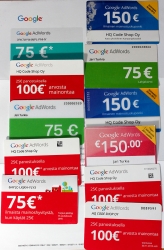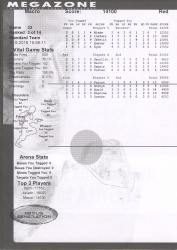Com Hem offering IPv6 /56 prefix to its customers
Monday, January 15. 2018
UUUJEA! ![]()
Com Hem has been rolling out a native SLAAC/DHCPv6-based IPv6 to it's entire customer base, and they took a very important step 2 in their project. They started honoring Prefix Delegation -requests! To a non-network person that means absolutely nothing, but to a network administrator that is really a game changer!
Normally I don't use much of the features my Sagemcom cable-TV -router has, it's just set to bridge:
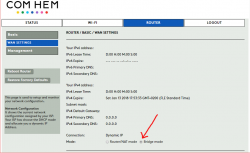
Since I failed earlier to get a prefix from my ISP, I was toying around with my router and set it to router-mode, and to my great surprise:

The thing issued my LAN a /64 IPv6-network! Nice.
After putting everything back and eye-balling the DHCPv6 lease file on my Linux-router:
lease6 {
interface "enp1s0";
ia-pd c4:d0:0a:85 {
starts 1515858667;
renew 302400;
rebind 483840;
iaprefix 2a04:ae00::/56 {
starts 1515858667;
preferred-life 604800;
max-life 2592000;
}
option dhcp6.status-code success;
}
}
Yes, it contains an ia-pd -section! The iaprefix from the file is mine, only mine, my precious address space! ![]()
I have no idea how long they have been honoring my PD-requests, but on December 17th they didn't.
A generally accepted IPv6-deployment principle is to follow RFC 5375 [IPv6 Unicast Address Assignment Considerations]'s suggestions and issue a minimum of /64 (18E IPv6 addresses) to customers. Since this /64 is completely useless for your own LAN, a second suggestion is to issue a /48 (1,2 million E IPv6 addresses) or /56 (4700E IPv6 addresses) prefix for consumer's own LANs.
Note: 18E is SI-prefix for exa, aka 10^18. A /64 IPv6 network has 18,446,744,073,709,551,616 unique addresses in it.
The numbers are astronomically big and it's quite easy to get confused and lose the perspective what they actually mean. A more concrete approach is, that by being issued a /56, I can now split my prefix into 256 separate /64 networks as I please. It's not like I need 256 LANs, I'm totally happy get even 1 of them to work! ![]()
Now I have my hands full to configure and test everything on my LAN. I need to make sure, that native-IPv6 works for wired and wireless toys I have here.
Com Hem offering IPv6 via DHCPv6 to its customers
Sunday, December 17. 2017
A month ago my ISP sent information that they're upgrading my connection speed without increasing the monthly cost! Nice. Totally unexpected from them.

Couple weeks ago my internet connection had dropped during night and I just flicked the switch on the cable router and it all came back. What I didn't initially realize, that I had an IPv6-address! WHOA!
Given zero public information about this on their public website, customer portal or anywhere, I just saw that on my network interface while investigating an another issue. They are broadcasting router advertisements and allocating a /64 from 2A04:AE00::/26 (SE-COMHEM-20140210). It looks like this on radvdump:
interface enp1s0 {
AdvSendAdvert on;
# Note: (Min,Max)RtrAdvInterval cannot be obtained with radvdump
AdvManagedFlag on;
AdvOtherConfigFlag on;
AdvReachableTime 600000;
AdvRetransTimer 0;
AdvCurHopLimit 64;
AdvDefaultLifetime 9000;
AdvHomeAgentFlag off;
AdvDefaultPreference high;
AdvSourceLLAddress on;
AdvLinkMTU 1500;
}; # End of interface definition
Since the O-bit for "other" (AdvOtherConfigFlag on) is enabled, it means that a DHCPv6-request will get more usable information. A DHCPv6 lease will look like this:
lease6 { interface "enp1s0";
ia-na xx:xx:xx:xx {
starts 1512476381;
renew 302400;
rebind 483840;
iaaddr 2a04:ae07:yyyy:yy::yyyy {
starts 1512476381;
preferred-life 604800;
max-life 2592000;
}
option dhcp6.status-code success;
}
option dhcp6.client-id 0:1:2:3:4:5:6:7:8:9:a:b:c:d:e:f:10:11;
option dhcp6.server-id 0:1:0:1:53:f:97:74:0:50:56:a8:22:a4;
option dhcp6.name-servers 2a04:ae3a:ae3a::1,2a04:ae3a:ae3a::2;
}
It works and is fast and all, but ... (there's always the but part). Given SLAAC, they issue only a /64 prefix. Why is that a problem you ask. Well, to be able to issue an IPv6 address to all devices in my LAN, that's not enough.
I tried sending a Prefix Delegation -request via DHCPv6, but no. They didn't honor that request. Should that worked, I'd be happy. I'd have my own /48 prefix for my LAN-devices.
In the current form Com Hem's IPv6 is mostly useless as none of my actual devices have IPv6 addresses in them. I'm investigating this and if/when I find a solution for this, I'll post something about it. Meanwhile, if you know how to get a prefix out of them, please inform!
Finnish movie chain Finnkino and capacity planning
Tuesday, October 10. 2017
In Finland and Sweden, all major movie theaters are owned by Bridgepoint Advisers Limited. In Finland, the client-facing business is called Finnkino.
Since they run majority of all viewings of moving pictures, they also sell the tickets for them. When a superbly popular movie opens for ticket sales, the initial flood happens online. What Finnkino is well known is their inability to do capacity planning for online services. Fine examples of incidents where their ability to process online transactions was greatly impaired:
- 2015: Star Wars: The Force Awakens
- 2016: Rogue One: A Star Wars Story
- 2017: Star Wars: The Last Jedi
The sales of movie tickets happens trough their website. I'd estimate, that 100% of their sales, either eletronic or physical points-of-sale, is done via their sales software. The system they're using is MCS, or MARKUS Cinema System, which according to their website "can be deployed both on premise and on Microsoft Azure". Out of those two options, guess which mode of deployment Finnkino chose! ![]()
Quick analysis indicates, that their site is running on their own /28 IPv4 network. Nice!
Based on eyewitness reports, their entire system is heavily targeted to serve the local points-of-sale, which were up and running, but both their online sales and vending machines were down. So, I'm speculating, that their inability to do proper capacity planning is fully intentional. They choose to throw away the excess requests, keep serving people waiting in queue for the tickets and sell the tickets to avid fans later. That way they won't have to make heavy investments to their own hardware. And they escape from this nicely by apologizing in Twitter: "We're sorry (again)." And that's it. Done!
Hint to IT-staff of Finnkino: Consider cloud and/or hybrid-cloud options.
Google AdWords sending me free money?
Sunday, September 24. 2017
If you own your company and happen to use any Google services (I do both), then you're very likely to be approached by Google's AdWords marketing. They are pitching you initial free credits to use for your ads. Since my business really doesn't rely on advertising, or marketing or anything of such nature, I typically ignore any approaches regardless who is contacting me.
Google has this approach, that they send you snail-mail and the letter will contain a credit-card sized laminated card contaning my business' name and a discount code to be used during registration. As there are nice € sums of money in them, I never threw any of those away. And it so happened, that since I kept ignoring Google's marketing machine, they just kept sending me those cards over and over again.
There is 1150,- € worth of free advertising in those. ![]()
You at Google:
Keep sending them, I'll keep collecting them. And amp up the values, I won't even flinch with your 150,- € coupons!
Go big! Go for 500,- € or even bigger!
Importing SVG-files into Google Drive - Illustrated Guide
Friday, July 14. 2017
I had a simple task at hand, to draw a flowchart how information is exchanged in a distributed system. Since I din't have my Microsoft Visio installed in that machine and the task was rather simple, I chose to try the Google Drawings and learn it. Easy as pie, right? Nope.
As one of the first things I wanted in my flowchart was "regular Jane User" and I wanted shape of a laptop computer to represent her. Well, Google's shape library didn't have a laptop, so why not go google for it and ta-daa! Found a suitable in couple of mouse-clicks at http://www.flaticon.com/free-icon/apple-laptop-computer_22791. Vector version available in multiple formats, so I downloaded the SVG into my Google Drive and ...
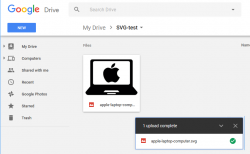
An hour later I simply gave up. Nothing in G Suite knew how to use that. And I did attempt a lot of things. Including converted the things into a .wmf as suggested by StackExchange article Import SVG files to Google Docs as a drawing.
It. Simply. Does. Not. Work! ![]()
Given the vast amount of proof, there must have been a time when it did work, but doesn't do that anymore. However, after an another hour later I found article How to import SVG (or any vector) into GoogleDocs from Google Docs Help Forum, which claimed that .emf would work. And oh joy! It does! ![]()
So, this is my illustrated guide of importing SVG into Google Docs/Drive/Suite ... whatever they choose to be called today. I'm sure this information will eventually be as invalid as so many pages around The Web are at the time of writing this, but I'll leave my mark to The Net with this one.
In this guide I'm doing everything in Google Drive. In reality you have lots of options to do this and go with a completely another path and still end with the same result, but I try to keep this as simple as possible.
- Upload all the required
.svg-files into Google Drive - Right click a .svg-file and choose Open with > CloudConvert
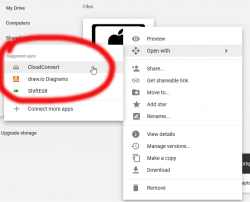
- (one-time-task) Accept CloudConvert OAuth request
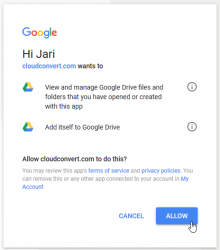
- (if returning from CloudConvert account creation), do 2. again and choose Open with > CloudConvert
- At CloudConvert, select vector > emf, and make sure Save file to my Google Drive is checked. Then hit Start Conversion:
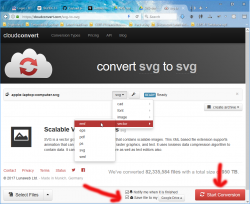
- You can convert any number of files at one run, when conversion is done, close CloudConvert:

- Return back to Google Drive. You will find the
.emfversion of your file in the same folder the original.svgconversion was started:

- Right-click the .emf file, notice how you CAN open it in Google Drawings:
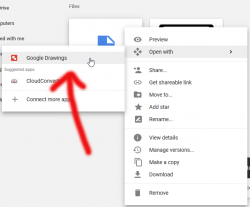
- In Google Drawing, copy the file Ctrl-c in Windows or ⌘-c in Mac:

- If needed, you can paste (Ctrl-v in Windows or ⌘-v in Mac) the converted symbol into any other type of Google document, for example presentation:
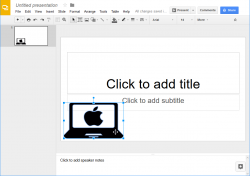
- When looking at your Google Drive, there are three versions of the same file. To get rid of not-so-useful ones, which two to delete (from left to right:
.emf, Google Drawings and.svg):
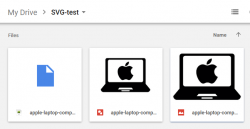
- To make sure you're keeping the Google Drawings one, right click any file and select View Details:
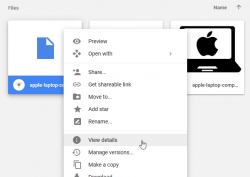
- Keep the one saying Google Drawings, delete rest:
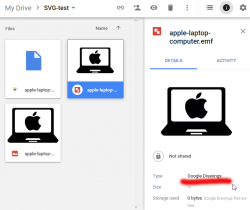
- Done!
I don't know why people at Google think this is a fun sequence to do for dozen or so symbols. They could easily do this conversion pretty much automatically for me.
Btw. The above laptop icon needs to be attributed:
Icons made by Freepik from www.flaticon.com is licensed by CC 3.0 BY
Mobile speeds - Summer 2017
Thursday, June 29. 2017
Somebody has got new toys. I was just doing a casual Speedtest for my mobile subscription to see if it would have any oompf in it. This is the result:
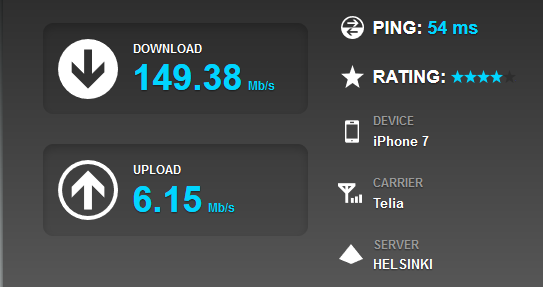
Holy cow! Nearly 150 Mbit/s download. On an iPhone 7! Whaat?
I was just having a burger in Stockholm, my subscription is Finnish, so all the traffic will exit from a Finnish IP-address. That makes the ping bad, but the download speed is trough the roof.
Here are couple of other measurements from Finland (thanks guys for these!):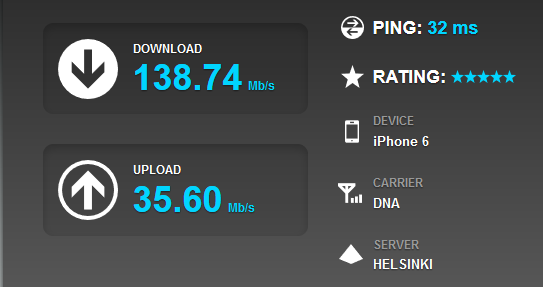

Similar style results on both cases.
I don't know what changed, but Finnish telcos have really amped it up. No complaints from me! ![]() Nice!
Nice!
SixXS - Thank you for your service! Let there be native IPv6 for everybody
Monday, June 5. 2017
Ok, we've established earlier, that IPv6 isnt' getting traction. ISPs are simply to lazy and they don't care about their customers, only their profits matter. It's really bad for profit to do improvements on their systems and networks. Meanwhile IPv4-addresses ran out on IANA, but ISPs don't care about that either, they stockpiled addresses and have plenty to go with.
To get IPv6 on my systems, I've been using free-of-charge service SixXS for almost 10 years. They provide IPv6-on-IPv4 -tunnels using IP-protocol 41 or 6in4. The tunnels I've been using in Finland have been provided by local ISP, DNA, again free-of-charge. During those years of service, I managed to accumulate almost 7000 ISK, that's 5 ISK per week per tunnel, if the tunnel is running without any problems.
On IPv6 day (6th June) 2017 SixSX will shut down all services. See, sunset announcement for their rationale for doing this. They pretty much say, that they ran tunnels for 17 years and don't want to do that anymore, ISPs should provide native IPv6 to every single customer they have. I'm totally agreeing with them. I'd like to keep my tunnels running, still. ![]()
It is what it is, decisions have been made and it's not going to change. So, my sincere thanks go to SixXS and DNA, and especially to all the hard working people on those organizations. Thank you for your service!
Advent calendar 2016
Thursday, December 1. 2016
Unlike last year, I didn't manage to get me an advent calendar this year. Unfortunately for me, Central European on-line stores won't do deliveries to Finland anymore. ![]()
This year I had to go for a much less elegant solution:

That's one for each of the 24 days. ![]()
Personally I'd prefer the real ones I had for the past couple years, but this will have to do.
Why is there no real commitment for IPv6?
Saturday, October 29. 2016
I've been an active IPv6-user for many many years. Of course my ISP doesn't offer a native IPv6, so I'm using a tunnel from SixXS. They have been providing such tunnels free-of-charge for years, and for that I thank them and the ISPs volunteering their capacity for us nerds to have decent IPv6-connectivity. SixXS got tired for IPv6 not getting any traction, the ISPs have almost zero commitment for allowing people to use real, native IPv6. SixXS has a campaign called "Call Your ISP for IPv6!", but I don't think that's going to make much of an impact. When any ISP is actually asked about their IPv6 support, they'll stall by "we'll announce it later" or "but we do support IPv6" (by some unusable mechanism).
When looking what's happening on the ISP-side, Telia (or Sonera, as we call it here in Finland) has enabled 6rd for their connections. It combines DHCPv4 by returning enough parameters for an IPv6 setup with a 64-bitmask to be done. It kinda works, but ... still not the real thing I'm after. Also Elisa and DNA, two big mobile telcos in Finland, started offering IPv6 (DNA, Elisa) for their customers, but ... I'm not going to change my home fiber for a mobile connection. So something is happening at the telco-scene. I'm just waiting my ISP (Elisa) to act on the wired side too.
The other side of the chicken-egg -problem are the services. There is no real commitment on their side either. For example Amazon AWS (a really huge infrastructure provider) really doesn't support IPv6, they have nice IPv6 support for Internet-facing load-balancers, their S3 storage and their content delivery net Cloudfront, to mention few. But when it comes to running a server instance with real native IPv6, no dice. So, you can market your service to be IPv6-ready, all the critical Internet-facing services really do support IPv6, but your infra runs on IPv4 private addresses. Not cool.
And when it comes to services, this is a typical scenario:
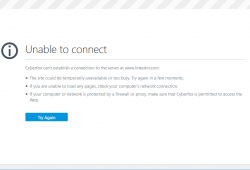
That's what's been happening for LinkedIn for I-don't-know-how long. At least this week.
Me being the nerd I am, some background investigation:
# telnet www.linkedin.com 80
Trying 2620:109:c007:102::5be1:f881...
telnet: connect to address 2620:109:c007:102::5be1:f881:
Connection timed out Trying 91.225.248.129...
Connected to www.linkedin.com.
Escape character is '^]'.
A classic. ![]()
Their IPv6 is down and they don't know about it. This is their level of commitment:
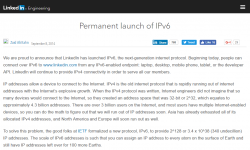
On September 2014, they announce to have done a "Permanent launch of IPv6". But none of them are using it themselves to realize it has been down for a week! The really scary thing is, that they cannot afford $10 a month for a Pingdom check. 
That's what I recommend for everybody to use for monitoring on-line services. Any reputable admin needs to know the second a service is out of reach by general public. IMHO that should include also admins at LinkedIn.
When it comes to lack of IPv6, I need to come clean. This blog isn't running on IPv6 either. Since most of you don't have it, it is impossible for you to know. My co-location host cannot offer me the IPv6, so no avail. ![]()
But why? Why is there no real commitment for IPv6? What's blocking all sensible people for going all-in IPv6? Everybody knows, that all possible IPv4 addresses were allocated by IANA to telcos and ISPs in January 2011. So, there is no more. Of course there are plenty of available addresses in RIRs to allocate for regional telcos, so we're not completely bankrupt with IPv4-addresses. But that day is eventually coming, it's just a waiting game. Notable efforts like World IPv6 Launch Day yield no mentionable results.
So what's holding us back? I don't know anything else except everybody going on the path-of-least-resistance. Since there are available IPv4-addresses, why risk a change. With change things can go broken or something may shift so that some people will lose some and others will win some. Not that much of a risk, if you ask me. But here we are, inching towards IPv6 very slowly. Speed it up, goddamnit!
Fixing Google's new IPv6 mail policy with Postfix, part 2
Wednesday, September 14. 2016
I got a comment from Mr. Martin, that Google changed their SMTPd, so I'll have to revisit the article.
As suggested, new /etc/postfix/smtp_reply_filter would be:
#New 2016/09:
/^5(\d\d )5(.*. \S+ - gsmtp.*)/ 4${1}4$2
Above one is working perfectly on my box.
Again, thanks for Mr. Martin for bringing this topic to my attention.
Amazon EC2 spot prices
Friday, August 26. 2016
I was about to do some testing with a cheap Elastic Compute Cloud Linux-instance, but ... AWS wouldn't allocate me one.
Here is the reason from Amazon EC2 Spot Instances Pricing:
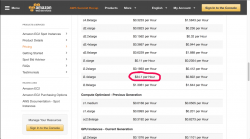
Somebody really lost his marbles and is paying ludicrous price for a box. ![]()
Ok, in reality that has to be work of two (or more) automated systems competing with each other in a situation where capacity of i2.4xlarge instances is scarce. Any human would do what I did, just pick the bigger box and be happy about that. That instance type with normal pricing costs like $3.41 / hour, and with spot pricing it goes ~60 cents / hour, but not when automated bidding goes haywire. ![]()
Megazoning (or Laser Tagging)
Wednesday, June 29. 2016
I'll post something about not computers for a change. Its pretty close, but still, not about computers.
Any self-respecting nerd (such as me) loves video games. Doing first-person-shooter games IRL is always both fun and a lot more difficult than on a computer.
We had a company activity and went to nearby Megazone for couple rounds of always fun laser tag. Since it was my first time ever doing that, it was like a slap in the face. I'm a 2nd lieutenant in FDF reserve, so I have basic understanding of tactics in a battle. Also I've played video games since early 80s and FPS games since first Wolfenstein. On top of that I've been paintballing enough to know that there is enough realism in video games and paintballing to match real military tactics. However, anything I knew about combat, tactics and fighting at that point was usless.
In the game there were three teams and you, so pretty much everybody you see is an enemy. Megazone is mostly about movement and speedy tags of any visible opponents. The worst thing that can happen to you there is that you're unable to fire your weapon for 8 seconds. During a 25 minute round that's not too dangrous. In paintball or war you're out on the first "tag", here you aren't, it's just a game of accumulating points.
Here are my stats from first round:
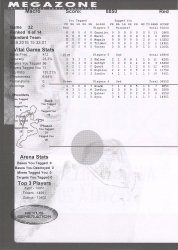
I sucked! ![]()
My handle in the game was Macro (in the Red team), so being 8th out of 14 wasn't that good. Tactically the maze was a nightmare! In the original Wolfenstein it was possible to be hit only from front, back or sides. In Megazone there were 2 floors, but it was a metal grid walkway making it possible to shoot trough. That made it 5th direction where getting hit was possible. At best I found couple locations where it was possible to get some cover and get hit only from two directions. The only even semi-functional tactic I found was to ignore any defence, cover and cautiousness. Just going recklessly forward and out-gunning everybody on a reaction seemed to work good. Also sniping people long-range was a really good tactic, sometimes I could do 4-5 people from a single position. They never saw me. I also did try attacking enemy bases and defending own base, but they were totally pointless exercises in futility, I spent too much time trying to figure out the value of those.
Quite an improvement in points and ranking. I was best in our team and 3rd in total!
Megazone was great fun, but with my background, it'll never be my favorite thing. I want to see my opponents suffering when I hit them, in laser tag that doesn't happen. ![]()
Recycling used Samsung laser printer cartridges
Wednesday, January 6. 2016
Every now and then I need a paper copy of something. In Finland, which to my observations is quite far advanced in the paperless processes (working environment or otherwise), that's rare. The obvious exception to the rule is bookkeeping and banks. They won't live without a hard-copy of something. For the purpose of producing a printout I have a Samsung color laser printer. When it was new, I even made a humorous note of it.
The general grievance about modern printers is, that they cost around € 200,- and almost immediately run out of [insert a name of expensive supply product here]. In my case, nothing else than all colors cost way above € 300,-. But that's not my rant-of-the-day, I knew all about that when I decided to have the unit shipped to my front door. Korean engineers @ Samsung made the actual process of changing a color cartridge a very simple one. I have to say, that hardest part in that is un-boxing the new ones. They are so tightly vacuum-sealed. So, no groaning about that one either.
What do you do with those darned expired things, when you're done!!
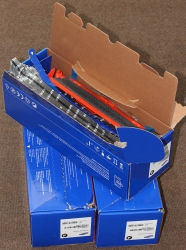
I had replaced the black cartridge earlier, it always runs out first. In this instance, I replaced only the colour ones (CMY). So, only 3 useless boxes to throw out of the house.
From The Web, I found somebody having the same problem. This article is in Finnish, but it's pretty much about Samsung color cartridge not having any kind of recycling info in it. Samsun's rep reponnds, that "oh yes, there are instructions". This is the only thing I found about the subject:
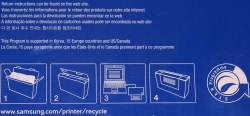
It says to go to www.samsung.com/printer/recycle for information. I did and landed at Samsung S.T.A.R Programme (Samsung’s Takeback And Recycle). It has following information about returning used cartridges at How to return your used cartridge -page:
- Place your used cartridge in the bag and box which came with your new Samsung toner cartridge. In case you wish to send more than one cartridge for recycling, please put all cartridges in one big box, or tape the individual boxes together.
- Close the box using clear tape;
- Register yourself/your company on our STAR website. In case you have already registered yourself/your company, please log in using your user name and password. Chose the number of empty cartridges you would like to return and press the ‘get your label!’ button. Your order will be processed immediately. Only one (1) return label will be sent to your registered email address or will pop up at your screen;
- Print the return label and place it on the large side of the box. If the return label contains a bar code, please keep this bar code visible;
- Drop off your box at the nearest post office or include it in your usual mail collection.
Well, I guess I'll have to register to the site and get myself some clear packing tape. After doing that, it was possible to print following packing slip:
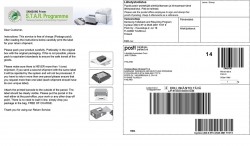
Looks like a valid customer return information required by postal services. Now the last thing is to go to a post office and leave the bundle there.
So, the information was there. Obviously the entire process is a bit more complex than just taking out the garbage, but I guess Samsung guys will properly handle all the troublesome waste there. That should save the Earth! ![]()
Advent calendar 2015
Sunday, November 15. 2015
Like last year, I happened to get me an advent calendar this year too. The layout is a classic 24 x 0,5L containing 24 lids for the days in random order:

There seems to be .... erhm.... problems transporting alcohol to Finland, and many European vendors have pulled Finland off their available destinations. Amazon.de still delivers Lieferello goodies to us, so I got my Drinks & Fun Die Weihnachtsbrauerei Bier-Adventskalender. The same thing at Lieferello site would be here.
Now I'm just waiting for the 1st of December. ![]()
Update 17th and 28th Dec:
To squash a FAQ: The beers in the calendar are different. It wouldn't make any sense to buy a 24 pack of beers and call it an advent calendar. See:





- Felsgold Premium Pilsener
- Carl Theodor Lager
- Felskrone Premium Pilsener
- Pilsator Pilsener
- Durlacher Hof Weissbier
- Brauburger Premium Pilsener
- Harboe Bear Beer Strong Stout 8%
- Eichbaum Red Beer
- Edel Bayer Urtyp Hell
- Darguner Pilsener
- Kress Bayrisch Zwickel
- Barbarossa Premium Schwarzbier
- 5.0 Original Pils
- Durlacher Hof Weissbier (Hefeweissbier)
- Frankenthaler Germania Premium Strong
- Regenten Pilsener
- Maisel St. Michaelsberg 1122 Premium Pilsener
- König Wilhelm Hefeweissbier
- Mecklenburger Pilsener
- Dinkelacker CD-Pils
- von Raven Pilsener
- Eichbaum Pilsener
- Barbarossa Brauerei Helles Hefeweizen
Fixing Yleisradio (The Finnish Broadcasting Company) HTTP proxy Fail
Monday, March 23. 2015
When it comes to unlimited supply of failures, one of my absolute favorites is YLE. Whatever they try, they seem to fail at it.
They have stumbled with their on-line service (Areena) a number of times. It took them years and years, but recently it has been at level, semi-decent service, no major failures, works even on iPad.
As they are having an uphill fight with piracy and people not obeying the country limitations they are forced by distribution agreements, they did the only sensible thing anybody can do: if you're using a HTTP proxy, then you're out! The only natural ruling can be that anybody using a proxy is accessing their service from abroad.
The license of this radio show says that they will apply geo IP restrictions to it to limit audience in Finland only "( Kuunneltavissa vain Suomessa )". It will result in sorry-you're-not-in-Finland ("Ohjelma ei ole kuunneltavissa ulkomailla") and a refusal to play. However I am in Finland, I should be allowed access to that.
These guys are known for their inability to think smart. It is impossible to know if somebody abroad is using a Finnish proxy or not. The only possible detection method is checking for X-Forwarded-For HTTP-header.
That should be an easy fix. Let's see:
# host areena.yle.fi
areena.yle.fi has address 91.229.138.2
areena.yle.fi has address 91.229.138.6
Whois information for their IP-block is:
% Information related to '91.229.138.0/23AS57066'
route: 91.229.138.0/23
descr: Yleisradio Oy
origin: AS57066
mnt-by: DATANET-NOC
source: RIPE # Filtered
Adding this to /etc/squid/squid.conf:
# Forwarded-for -stuff off for YLE
acl yle_areena dst 91.229.138.0/23
request_header_access X-Forwarded-For deny yle_areena
... and restart will do the trick! Squid-proxy fully supports this kind of behavior with acl and request_header_access -directives. Now YLE-people are blissfully ignorant about you using a proxy or not.
Update 24th Mar 2015 and 1st Jan 2016:
Also MTV katsomo.fi has gone for this stupidity. The fix is obviously:
acl mtv_katsomo dst 23.54.11.0/24 # Katsomo.fi (Akamai)
acl akamai dst 23.32.0.0/11 # Akamai
request_header_access X-Forwarded-For deny mtv_katsomo
request_header_access X-Forwarded-For deny akamai
Now they allow you to watch via proxy.
